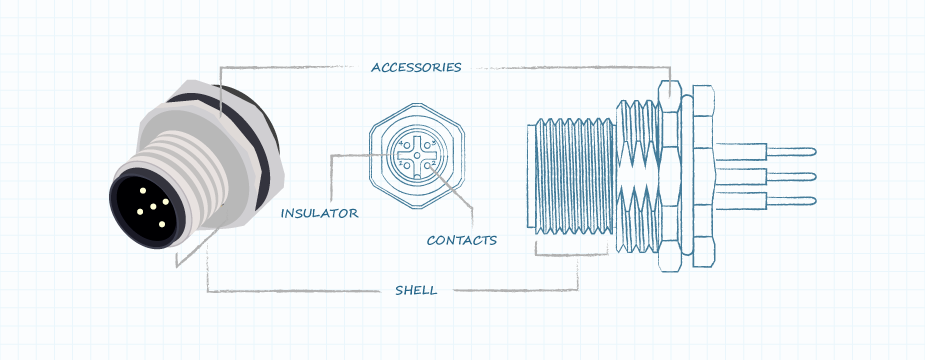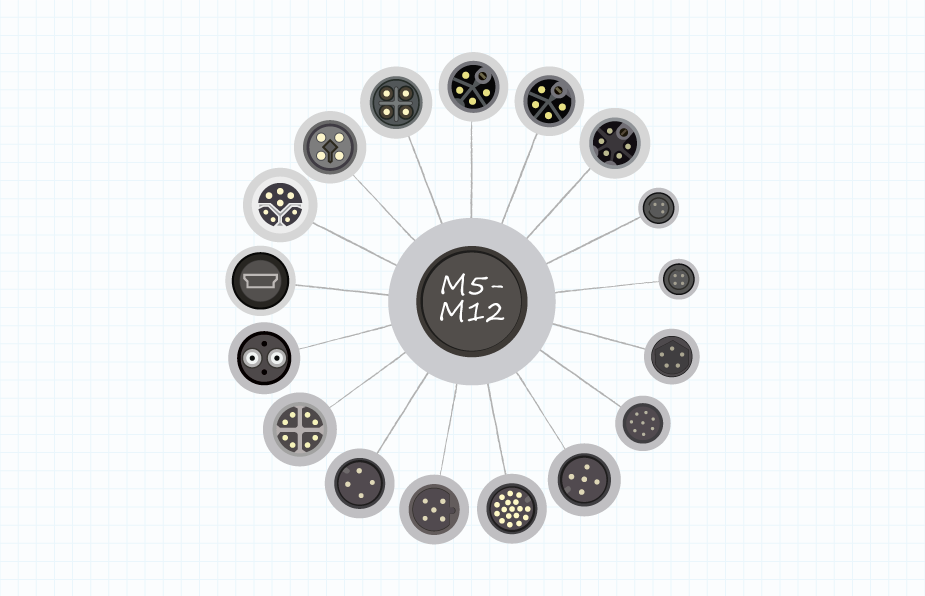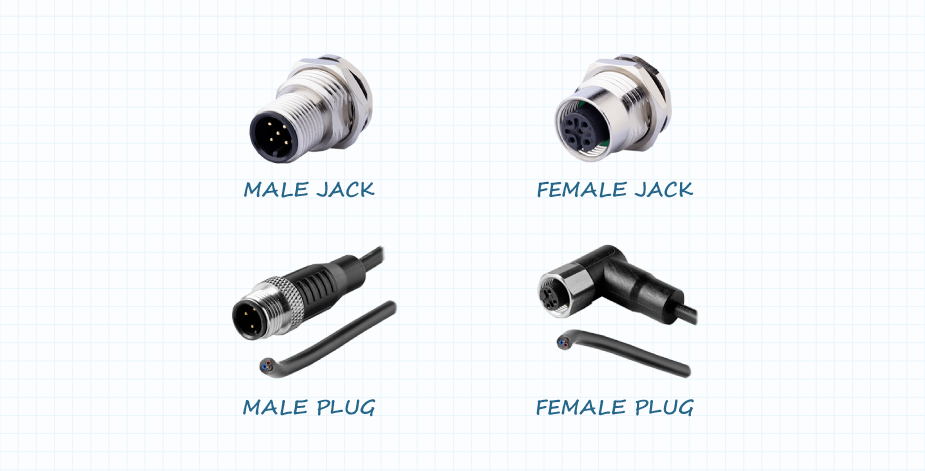Basic knowledge of circular connectors and cables
Circular connectors are cylindrical electrical devices of different sizes with circular mating surfaces. They contain multiple pins or contacts that connect to applicable components to transmit power, signals, or data. They can also be referred to as circular interconnects. Internal contacts are fitted with wires or cables to transmit signals.
Their cylindrical or tubular body makes these connectors particularly robust and resistant to vibration and shock damage, extreme temperatures and pressures, external signals or interference, and the intrusion of dust or gas.
The modern products currently offered in this category range from simple plastic, metal, or composite standard circular connectors to many other types, including DIN, metric, sealed, push-pull, keying, mixed-signal, and micron or nano versions. Provides hybrid options to combine power, signal, and data into a single device. You can also find modular or custom solutions that customize connector products for specific applications.
Circular connector features.
Their tubular or cylindrical shape gives circular connectors a higher strength-to-weight ratio than any other shape. This inherent strength resists external factors, impact damage and accidental decoupling. This strength also makes them useful and resilient in applications that require frequent plugging and unplugging. The number of internal pins or contacts varies by application, and the layout of the contacts or internal keys ensures proper alignment and insertion of the fitting device.
Circular connectors are most often (but not always) connected through a threaded area on the housing. This screw-in connection allows them to easily and firmly lock into place and remain in place in the event of vibration or shock. Other types of connection systems include bayonet locking, push/pull locking, and spring locking.
The basic structure of the circular connector includes the following:

Basic structure of female circular connector
Contacts - These are pins and sockets located inside the connector that fit together to form an electrical connection. The contact pair consists of a male contact pin and a female socket.
● Insulator - This is the material used to encapsulate the contacts and insulate them from each other and from the connector housing. The material can also hold the contacts in the correct position in the housing and properly distance them from each other.
● Housing - This is the housing of the connector to house the contacts and insulators. It can also provide alignment when the two halves of the connector fit together and secure the connector parts to each other or to the device.
Accessories - These are add-ons for positioning, guiding, clamping, securing, or sealing connector parts. They include pins, rings, keys, clips, washers, etc.

The basic structure of the male circular connector
A wide range of applications for circular connectors
Due to their high performance in extreme vibration, shock, temperature, pressure, and interference (EMI and RFI), circular connectors are increasingly used in many industrial applications that require power transmission, signal transmission, data transmission, and mixed-signal transmission (power + signal + data). They are best used when a robust connector construction is required, inlet protection is required, a secure plug-in system is required, or protection against EMI or RFI is required.
M5, M8, M12 names and codes
M-type circular connectors are a range of standard product types used to connect sensors and actuators in industrial networking applications. They are designed to operate in extreme conditions. The "M" designation refers to the metric thread dimensions on the connection nut and mating socket, i.e. the relative dimensions of the connector. The M5 connector has a 5mm diameter fastener, the M8 has an 8mm diameter fastener, and the M12 has a 12mm diameter fastener.
Circular connectors and cables are further divided into other categories depending on the keying or shape of the contact. Various codes ensure that the cable is installed with the correct connector. The different codes used and their definitions are as follows:
● A - Connectors for sensors, DC power supplies, and 1 Gbit Ethernet (a protocol used to connect computer systems to form a network).
● B - Connectors for fieldbus (industrial computer networks for distributed control) and Profibus (digital networking standard that provides communication between field sensors and control systems).
● C - Connector with double keyway for increased safety, AC power supply for sensors and actuators.
● D - Connector for 100 Mbit Ethernet and Profinet (protocol for data exchange between controllers and devices) systems.
● X - Connector for 10 Gbit Ethernet high-speed applications and Power over Ethernet (PoE).
● S - AC power connector (instead of C - coding part).
● T - DC power connector (instead of A - coded part).

Different circular connector categories and connection types
Applicable standard for circular connectors
Circular connectors are designed and manufactured in accordance with a number of different national and international standards organizations. Here are some of the standard bodies and names associated with the development and continued use of these products:
UL - Underwriters Laboratories standards related to circular connectors (UL1977 and UL2238) cover safety issues and properties of materials used in manufacturing.
The IEC - International Electrotechnical Commission standard defines and describes several types of circular connectors, including IEC 61076-2-113, which defines requirements for M12 connectors.
MIL/AERO - The military standard for circular connectors was developed by the U.S. Department of Defense in the 1930s and covers design and testing requirements for a variety of connectors, including circular devices.
EN- The European Standard (European Specification) covers the circular connector details in EN-IEC 61076. Other standards cover connector specifications by application.
IP - Inlet protection class is defined by IEC 60529 standard and covers protection against solids and liquids entering the body of the connector. ANSI 60529 covers IP in the United States and EN 60529 covers IP in Europe.
DIN - The German National Standards Organization (Deutsches Institut Fur Normung) standard covers circular connectors, in particular DIN 41524 and other documents.
VARAN - The multifunctional Automated Random Access Network is an Ethernet-based bus system implemented in machine automation hardware, including circular connectors.
Selection criteria for circular connectors
When you specify circular connectors for a new design or redesign, there are many criteria to consider. The first is whether your design requires a round plastic connector (CPC) or a round metal shell connector (CMC). Beyond that, here's a non-exhaustive list of parameters (in random order) that you need to decide:
● Category (Male/female) : The male part contains a stylus inserted into the socket or the female part of the socket. Most plugs and sockets are designed to fit within their own brand or manufactured product lines. Typically, connectors from different manufacturers will not interconnect. You will usually purchase connectors in the form of pairs, but not always.

Circular connector male and female fit
● Number of contacts: The number of conductive pins or contacts your design requires in the connector to carry the signal, data, or power you need to move.
● End connection: This is the way the wire or cable works with the conductive contacts in the connector. Some options include welding, winding, wiring, or crimping.
● Contact size: the diameter of each contact, or the wire specification that can be matched with each contact.
● Voltage and current rating: The maximum voltage or current that the connector is designed to carry. The rated current is the flow rate of the current, expressed in amperes (A). The rated voltage is the amount of voltage that can be safely carried and is expressed in volts (V).
● Insertion frequency: the regularity of connector connection and disconnection (also known as insertion and removal cycle). Frequent plugging and unplugging may require a stronger connector or cable protection attachment.
● Installation type: Connector installation method, including cable installation, panel installation or circuit board installation. Each type is suitable for different installation hardware.
● Coupling or locking mode: how firmly the connector fits. Locking methods include bayonet type, latch type, push-pull type, thread type and quick break type.
● Rear shell type: Connector The rear shell is threaded to the cable side of the circular connector to provide secure cable support. There are a number of different types of back shells to choose from, including straight, right Angle, braided tail, spring, stress relief, sealed and rolled.
Environmental factors: Will the connector be exposed to liquids, gases or immersion? Does the connector require protection against EMI or RFI signals? Are connectors exposed to corrosive chemicals, excessive vibration, or frequent impacts? The answer to each question will help determine the quality, functionality, and accessories you may need.
● Material used: The connector body can be stainless steel, aluminum, plastic, composite or brass, depending on your requirements and budget.
Accessories: Connector manufacturers offer many different types of accessories to enhance the functionality of their products. The list of these is long, but some examples include seals, jackets, and caps for locking liquids and gases, stress relief devices and cable clamps for protecting cable breaks, back shells for protecting connections, flanges, washers, and cabling for installation, and cable clamps for easier insertion/removal.
Plugs and sockets: While industry standards vary, typically sockets and jacks are associated with panel mount connectors, while plugs are connectors that are part of a cable assembly. Again, there is no standard convention for this naming, so different manufacturers may use alternative terms.

Different gender jacks and plugs
Application example
Since being introduced to military applications in the 1930s, the use of circular connectors has continued to expand. For example, today's process control systems and factory floor sensor networks are often in harsh environments, requiring interconnected products to operate reliably under challenging conditions.
Electronic medical devices also feature circular connectors to ensure that hospital staff always connect cables correctly and do not come loose when moving patients. Many other application areas that enjoy the benefits of connecting with circular connectors include:
● Process control and industrial automation
● Factory wiring
● Transportation
● Aerospace and Defense
● Medical Equipment
● Robotics
● Audio/video communication
● Radio and television communications
● Vitality
● Drone
● Test and measurement
summarize
Circular connectors have been used for many years and have proven themselves to be reliable components that can perform in a variety of harsh environments. RFWELL offers a wide range of circular connectors and cables to meet the challenges of almost any application.